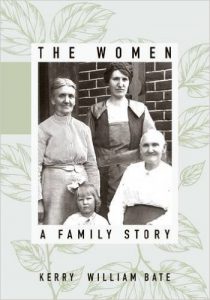Title: The Women: A Family Story
Author: Kerry William Bate
Publisher: University of Utah Press
Genre: local/family history, biography, women
Year of Publication: 2016
Number of Pages: 392 (notes and index begin on p. 315)
Binding: Hardcover
ISBN13: 978-1607-815167
Price: $39.95
Reviewed by Julie J. Nichols for the Association for Mormon Letters
Meticulously researched through oral history and primary and secondary documents, this lengthy work of family history represents a standard to which genealogists everywhere might aspire. Bate values not only his progenitors—their accomplishments, their relationships, their social context, their foibles—but also good stories, accurately and entertainingly told. The book offers a lively chronology from 1816 to the present describing characters, events, and attitudes that might prove interesting to many different kinds of readers.
First, Bate’s family—a wide-ranging cadre of Steeles, Roundys, Stapleys, Sylvesters, including in-laws, aunts, cousins, and nephews with such last names as Campbell, Hunter, Webster, and Reynolds, and neighbors named Davies, Olds, Hanks, and other familiar Utah names. You might be surprised to discover a relative or two here yourself.
Second, those interested in the history of Utah, from its settlement by Mormon pioneers (in the case of the Steeles, Irish immigrants) in 1847 to the present. Bate’s ancestors gave birth to the first white child born in Utah; helped establish Parowan; were implicated in the Mountain Meadows Massacre; heard Brigham Young preach that “there’s not a woman in this Church that Knows her duty” (15); dealt with Indians; and, in general, participated in some direct or peripheral way in nearly every important event in Utah history. To see these events through the lens of Bate’s family’s gives the events new energy and grounds Bate’s family in a familiar milieu.
A third group of readers this volume will appeal to are those interested specifically in local and recent history and social conditions pertaining to women. In his first chapter, Bate describes listening to his great-aunt Reba Roundy LeFevre’s stories of his grandmother and “suddenly realiz[ing] the importance of the story of the women in [his] family.” Fourteen of the seventeen chapters are dedicated to these women, specifically Catherine Campbell Steele; her daughter [Young] Elizabeth Steele, married to James Stapley; Elizabeth’s daughter Sarah Stapley, married to Joel Roundy; and Sarah’s daughter Sarah Elizabeth Roundy, married to Victor Sylvester. A helpful family pedigree chart allows the reader to keep these and their siblings straight. Bate is not Laurel Thatcher Ulrich, but his stories consciously address such matters as midwifery, fashion, cooking, house- and ranchwork, courting, business, and even aviation, quoting from letters and family and social histories to verify that the female members of his family embraced, resisted, or responded to all of these activities as they developed through the nineteenth and twentieth centuries in Utah.
A fourth kind of reader for this book is the family historian seeking to discover best practices in his or her own work. In The Women, Bate deals admirably with a relatively long and complex history, staying true to, and carefully citing, primary and secondary documents that provide context and background. His style is sometimes adjective- and list-heavy, and he sometimes strains to include all the quotations and other information gleaned from his research (describing a trip to the Painted Desert, he writes, “Kate [Sarah Catherine Stapley] loved the stratified and multicolored layers of Triassic Chinle siltstone, mudstone, shale, and petrified logs from a prehistoric coniferous forest” (297)). But his efforts to create a coherent narrative foregrounding the strong and very human women in his family’s past will, by and large, appeal to readers in ways more date- and fact-oriented family histories don’t always–as story, a logically-structured series of spirited anecdotes about characters whose lives develop in connection with other characters in imaginatively-recreated real places and times.
Enhanced with numerous black-and-white photographs of people, places, letters, certificates, and even house plans, this is an exemplary work of family history, sure to have wide appeal.

